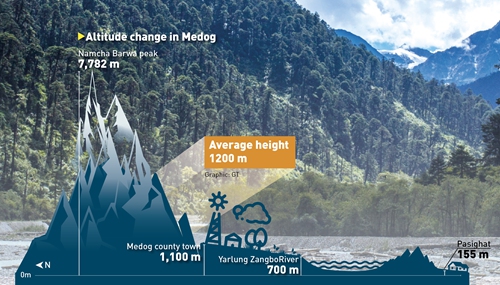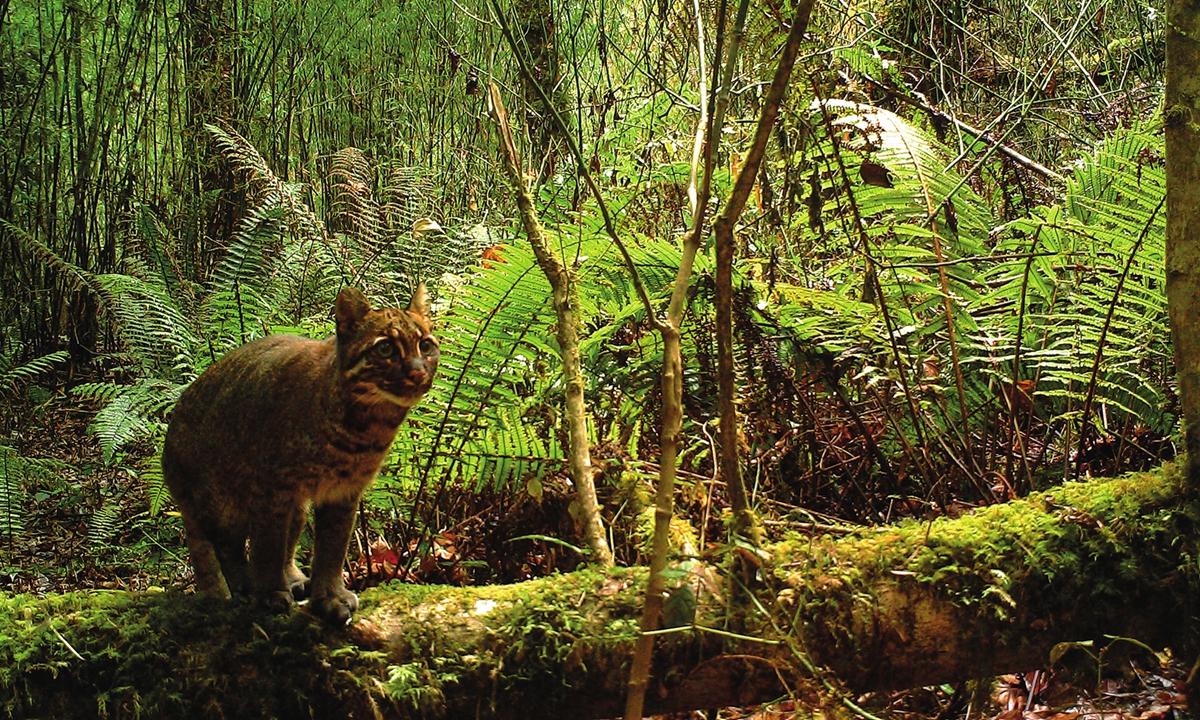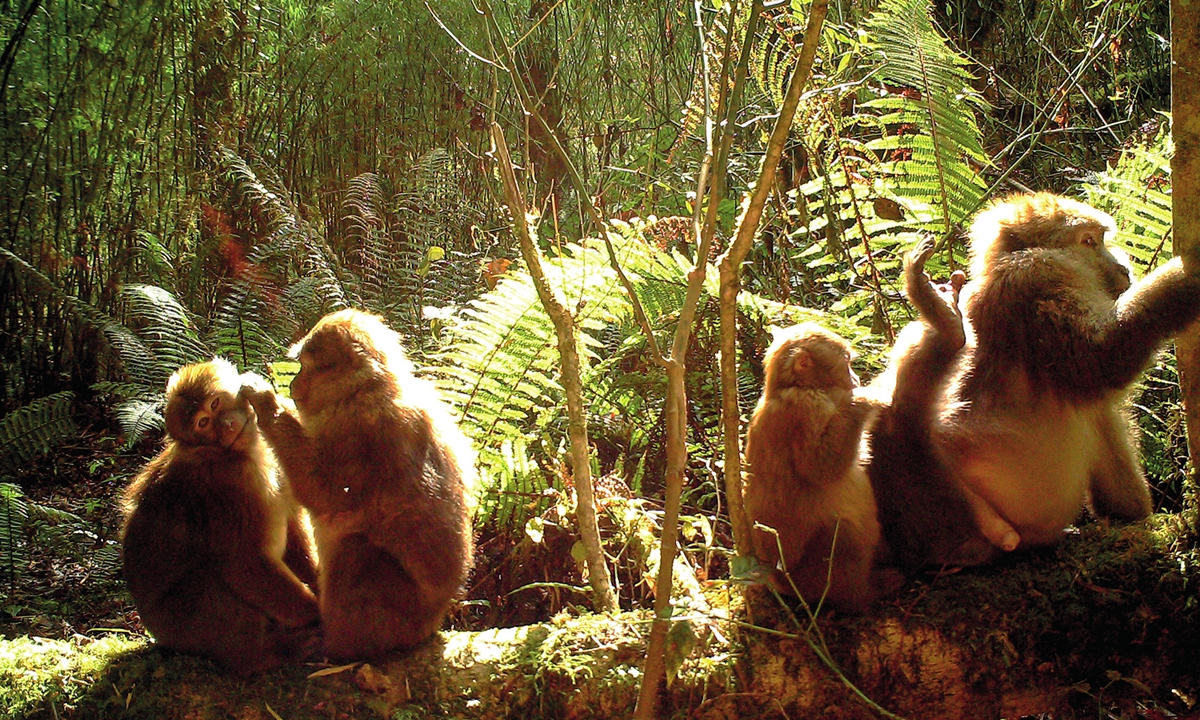
Coniferous forests of Medog, Southwest China's Xizang Autonomous Region Photo: Shan Jie/GT
The Yarlung Zangbo Grand Canyon in Xizang is one of the most mysterious and isolated places in the world. It is also a rich treasure of biodiversity.
The valley, the longest and deepest on Earth, is a secluded paradise for many old and rare species, which are able to freely multiply to this day away from the influence of human activities.
Meanwhile, it also faces enormous challenges. Some scholars and environmentalists have warned that human activities, climate change, and potential large-scale engineering construction could bring uncertainty to the future of the Yarlung Zangbo Grand Canyon ecosystem.
Luckily, people living in the nature reserve have elevated their awareness to preserve this treasure of nature. Protecting the forests has become a key task for Medog and other nearby regions. The local Monpa people have also given up hunting and have since switched hats to become forest rangers. Moreover, research groups have stepped up efforts in ecosystem preservation, quietly leaving devices to record and reveal the life of rare animals in the mysterious kingdom that could contribute to better protecting the wildlife in Yarlung Zangbo valley.
Since the founding of the People's Republic of China, the Communist Party of China (CPC) has led the people to combat in the battles against poverty. Since the 18th CPC National Congress, China has combined the poverty alleviation efforts with ecological conservation, with which people in regions with rich or fragile ecologic environment, such as the Yarlung Zangbo Grand Canyon, have been practicing.
For instance, starting in 2016, 1 million people living in poverty had been selected and hired as eco-rangers by the end of 2019, a policy to help residents shake off poverty by protecting forestry and grassland. The central government has provided 14 billion yuan ($2.2 billion) to support the eco-ranger system in three years.
Thanks to such policies, the precious resources of ecology have been maintained, while people living there are able to improve their income and livelihood.
Natural museum of biodiversity
It took almost nine hours to drive from the nearest airport of Nyingchi region of Southwest China's Xizang Autonomous Region to the town of Medog where the main body of the Yarlung Zangbo Grand Canyon National Natural Reserve is located.
The landscapes changed from the grassland that is a common sight in the highlands of Xizang, to mountains covered with tall spruces and pines that belong to the sub polar climate, to the jungle of huge banana trees and other plants from humid subtropical climatic regions where trees are always green.
It is no wonder the region of the Yarlung Zangbo Grand Canyon has such a value to study and maintain the biodiversity for the planet.
Yarlung Zangbo valley, 504.6 kilometers long with an elevation drop of more than 7,000 meters, is one of the top 34 biodiversity hotspots in the world. The valley has been dubbed a "Natural Vegetation Museum" because it is home to almost all terrestrial vegetation types from tropical to arctic zones, including some rare and even unique species.
It is also a habitat for many endangered animals, such as the cloud leopards and red gorals. It is China's only confirmed habitat for Bengal tigers.
It is distributed with 65 percent of the known higher plant species and 50 percent of the mammals on the Qinghai-Tibet Plateau. In total, more than 3,000 higher plants species can be found there.
The altitude Namcha Barwa Mountain stands at 7,782 meters in the natural reserve, while Pasighat, the lowest location in Medog is at around 155 meters. In a short distance, the huge vertical throw creates rich biodiversity, Liu Zhen, an official from the Forestry and Grassland Administration of Medog, told the Global Times.

Medog
"The valley is also a natural water vapor channel that brings wet air from the Indian Ocean, making a complete forest ecosystem in the region," Liu said. "Such a landscape is very precious and rare."
In 1985, the Xizang regional government formed the Medog natural reserve, which was upgraded to a national level the next year by the State Council. In 2000, its name was changed to the Yarlung Zangbo Grand Canyon National Natural Reserve and its area was enlarged.
Now, the total area of the reserve is more than 900,000 hectares, covering four counties and districts.
Scientists have said that there are still blanks in the assessment of biodiversity in this area, and new species and even new genera of vertebrates have been discovered in recent years, according to an article published on Nature in April.
In 2015, a paper on a new primate species - the White-cheeked macaque - first found in this area, was published; from 2005 to 2020, at least five new species of frogs or toads were announced found in the Medog region.
The Medog mole was first collected in 2019 by scientists from the Kunming Institute of Zoology under the Chinese Academy of Sciences in Medog. The Medog mole lives in bushes 2,400 to 3,700 meters above sea level and was only found in two towns in Medog. However, it belongs to the Alpiscaptulus genus and is related to moles living in America.
Another way to defend borders
Dechen Drolma and Metog, dressed in orange-vest uniforms and carrying water tanks, walk through the forests about one hour from the Medog township.
Drolma and Metog are forest rangers whose duty is to protect the forests in the region. They have to pay attention to potential fire hazards and pests.
Both women are villagers from nearby Miri village, in which all 36 households take part in forest conservation work and take turns to patrol. Every day the rangers are on duty from 9:30am to 6:30pm.
The two women, previously housewives, said that they understand the meaning of their job and wish to protect the forests.
A kind of precious tall and straight tree they are guarding is called the Subcostate Crape Myrtle, but local people call it the "monkey's cry" tree. "Because the trunk is so smooth that monkeys cannot climb up it," Liu said.
In the Chinese mainland, the "monkeys cry" tree could only be found in the Gaoligong Mountains of Yunnan Province and Xizang's Medog.
Since around 2012, Medog has formed a forest ranger team with 44 professional rangers, 51 captains, and 2,140 village rangers. Villagers can not only contribute to the ecosystem protection, but also increase their incomes.
As Medog is located along the China-India border region, many forest rangers also hold the position as border patrollers.
Tashi Tsephel, the director at the Gutang forest protection post, is one of them. Tashi leads his team to hold large-scale patrols every month, and has rescued wild animals at least 10 times.
While patrolling mountains and protecting forests, as border patrollers, Tashi and his teammates also participate in the protection of homeland security. He is an ecological warrior, but also a selfless border guard.
Keep the treasure
The uniqueness of the rare landscape as well as its location has made the ecosystem of the Yarlung Zangbo Grand Canyon more precious. Efforts to better explore, and efforts to find new solutions for the region's protection have never been halted.
With the support of a project of the National Forestry and Grass Administration, China's Shan Shui Conservation Center and Xizijiang Conservation Center cooperated to start a continuous infrared camera survey in Medog. As the first phase, 80 cameras have been installed in the forests of the Yarlung Zangbo Grand Canyon to record the life of wild animals.
So far, the cameras have recorded precious animals including Cloud Leopards, Black Bears, and Sumatrans and Red Pandas. They have also found six distinct colors of the Asian Golden Cat, a new breakthrough, according to Shan Shui via statements sent to the Global Times.

Asian golden cat Photos: Courtesy of Forestry and Grassland Administration of Medog

Alsophila spinulosa Photos: Courtesy of Forestry and Grassland Administration of Medog

White-cheeked macaques Photos: Courtesy of Forestry and Grassland Administration of Medog
Scientists and policy advisors are also exploring other ways to further preserve the ecosystem of the Yarlung Zangbo Grand Canyon.
Earlier this year, a Chinese political advisor suggested the country should accelerate building the Yarlung Tsangbo national park, an action to further preserve the local ecosystem that features rich biodiversity.
Building a national park in the lower reaches of the Yarlung Zangbo River and around its branches will be meaningful to protect the region of southeastern Xizang, resolve the contradiction between protection and development, promote national unity and maintain national security, said Zhang Endi, a member of the National Committee of Chinese People's Political Consultative Conference (CPPCC) from Shanghai.
Xizang has more than 60 regulations and laws involving environmental and ecological protection, according to a statement Xizang's delegation to the two sessions sent to the Global Times in March.
Around 45 percent of the area in the region is under protection within ecological "red lines." The region has built 47 natural reserves, accounting for more than 34 percent of the region's area, it said.
Moreover, Tibet has been turning woodcutters into forest rangers. Since 2016, more than 700,000 positions in environmental protection have been provided in the region.